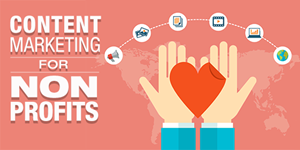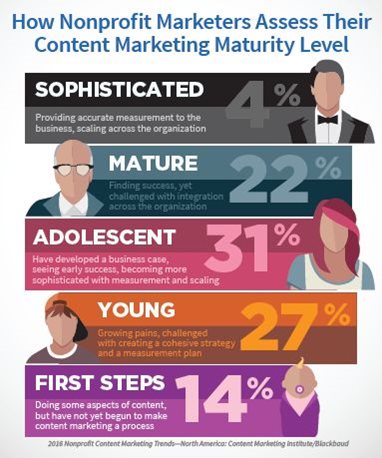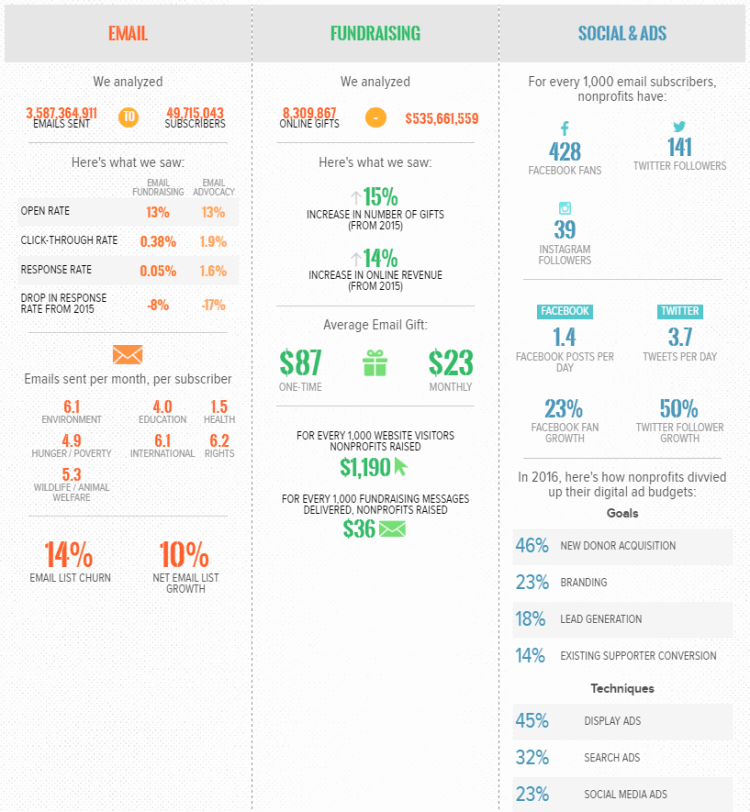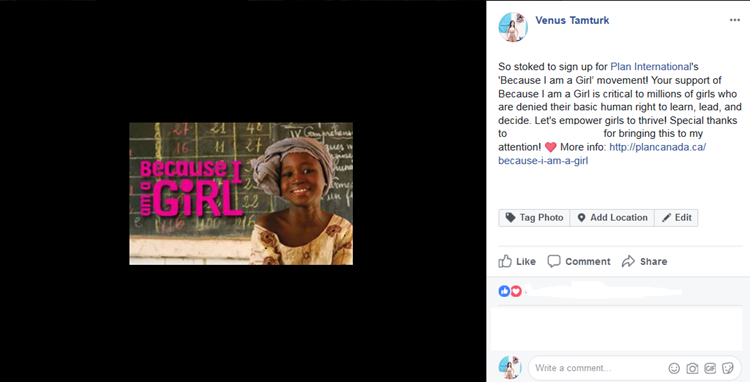A Content Marketing Strategy Guide for Nonprofit Marketers
You may recall Simon Sinek’s famous quote stating: “People don't buy what you do, they buy  why you do it." It is one of my favorite marketing quotes because it emphasizes the power of having a mission and a reason for existing. When he was pointing out that fact, he didn’t necessarily mean a specific type of a business but when I think of what kind of business could take tremendous advantage of this power, the word “nonprofit” started shining in light on the metaphorical marquee lightbox in my mind. When you think about nonprofits, they have all the elements from a strong core mission to a meaningful and inspirational story. What is left for the organization to do is to orchestrate them with a well-thought content marketing program that could unleash the power of having a strong mission so nonprofits can attract, engage, and convert target audiences.
why you do it." It is one of my favorite marketing quotes because it emphasizes the power of having a mission and a reason for existing. When he was pointing out that fact, he didn’t necessarily mean a specific type of a business but when I think of what kind of business could take tremendous advantage of this power, the word “nonprofit” started shining in light on the metaphorical marquee lightbox in my mind. When you think about nonprofits, they have all the elements from a strong core mission to a meaningful and inspirational story. What is left for the organization to do is to orchestrate them with a well-thought content marketing program that could unleash the power of having a strong mission so nonprofits can attract, engage, and convert target audiences.
In a nutshell, content marketing programs for nonprofits are not so different than B2B and B2C organizations but certainly, it brings its own opportunities and challenges within. For instance, the budget restrictions are more challenging for nonprofits than for B2B and B2C organizations but nonprofits’ stories and the root issues they are trying to solve are conducive to effective and efficient content marketing programs. Given $.25 of every dollar spent on content marketing in the average mid-to-large B2B firm is wasted on inefficient content operations, this tradeoff doesn’t seem to be a huge impediment for nonprofit organizations.
According to the National Center for Charitable Statistics (NCCS), 1,571,056 nonprofit  organizations are registered in the United States. Unfortunately, a study surveying 404 nonprofit marketers in North America illustrates that only 26% of nonprofit marketers say their organizations are effective at content marketing. Furthermore, the same study suggests that nonprofits use an average of 12 different content marketing tactics. To me, therein lies the opportunity for nonprofits. As aforementioned, the tight budgets and the lack of staff pose the biggest challenges for nonprofits and jiggling between 12 different content marketing tactics probably won’t cut it. Conversely, focusing on less could bring more when they embrace the most effective mediums and content types for their audiences.
organizations are registered in the United States. Unfortunately, a study surveying 404 nonprofit marketers in North America illustrates that only 26% of nonprofit marketers say their organizations are effective at content marketing. Furthermore, the same study suggests that nonprofits use an average of 12 different content marketing tactics. To me, therein lies the opportunity for nonprofits. As aforementioned, the tight budgets and the lack of staff pose the biggest challenges for nonprofits and jiggling between 12 different content marketing tactics probably won’t cut it. Conversely, focusing on less could bring more when they embrace the most effective mediums and content types for their audiences.
Benchmarking For Nonprofit Marketers
Although every organization has unique needs and audience, benchmarking is always a good starting point to get a sense of what could work and what could not. To that end, let’s take a look at some takeaways from M+R’s 11th Benchmarks Study of nonprofit digital advocacy, fundraising, social and advertising.
Investing in digital advertising - including search advertising (ie. Google AdWords), display advertising (ie. Google remarketing ads), social advertising (ie. Facebook advertising) - increased by 69% in 2016. To be more specific, education nonprofits in M+R's study invested the largest amount as a percentage of online revenue.
Email accounted for 26% of all online revenue in 2016. Furthermore, for every 1,000 email messages delivered, nonprofits raised $36. Bad news, nonprofit email open rates dropped by 7% in 2016, averaging now at just 15%. Since many nonprofit professionals believe eNewsletters are an effective content marketing tactic, stepping up their email marketing games through personalized content may cease the drop. One of the reasons for the decrease in effectiveness of email marketing is the increase of email sent which is about 10%. To stand out from the crowd, it is becoming imperative to tailor content based on donors and supporters’ interests and needs.
Email marketing is not the only tactic nonprofits have adopted because social media is another table stake. The study demonstrates that for nonprofits, Facebook audiences grew 24%, Twitter 50% and Instagram a whopping 101%. The sheer volume of Instagram followers may be the fruition of the launch of Instastories because storytelling is the bread and butter of successful content marketing for nonprofits, which we will dive deep into shortly.
Since the report is packed with much great information, the research firm created the infographic below to encapsulate:

What Sapiens, Marketers, and Impactful Storytelling Have in Common?
You might have heard the book called Sapiens by Yuval Harari as it’s been very popular lately.  The book is jam-packed with amazing data goodness on the human history but when I was reading it, these lines particularly stood out from the book for me: “Gossip played an important role in the development of Sapiens as the dominant species on Earth.” He argues that the new linguistic skills that Homo Sapiens acquired about 70,000 years ago allowed them to gossip for hours on end. As a result, reliable information on who could be trusted meant smaller bands could expand into larger ones and larger numbers of strangers can co-operate successfully by believing in common myths, according to the book.
The book is jam-packed with amazing data goodness on the human history but when I was reading it, these lines particularly stood out from the book for me: “Gossip played an important role in the development of Sapiens as the dominant species on Earth.” He argues that the new linguistic skills that Homo Sapiens acquired about 70,000 years ago allowed them to gossip for hours on end. As a result, reliable information on who could be trusted meant smaller bands could expand into larger ones and larger numbers of strangers can co-operate successfully by believing in common myths, according to the book.
Now obviously, I am not suggesting nonprofits talk with their audiences behind each other’s back. My point is that this inherited instinct illustrates two important social elements that all marketers could harness. The first, is that what made people expand their reach in the first place wasn’t technology, yet it was their ability to tell a story. In other words, the appearance of fiction did the trick. The second pattern retrieved from this finding is that it is more trustworthy when it is familiar and relevant. Fast forwarding 70,000 years, what are the equivalent content marketing tactics to leverage these social elements? Storytelling and user-generated content (UGC).
Remember my metaphorical marquee lightbox mentioned in my opening statement? The reason that it shone the word of “nonprofit” is the very reason that makes nonprofits advantageous to captivating and inspiring storytelling which is the power of having a mission and a reason for existing.
Content Marketing Tactics for Nonprofits
Since we, as humans, have been telling stories for 70,000 years, I am not going to expand on how to do so, but instead, I will discuss some content marketing tactics that nonprofits especially under-resourced and with tight marketing budgets could take advantage of to tackle some of the most common nonprofit challenges/objectives that include:
-
Acquiring new donors
-
Engaging community
-
General brand awareness
-
Donor retention
-
Scaling
Curate your perfectly uncomplicated messaging: Nonprofits typically cover the range of social, health, and environmental issues facing society thus messaging should be perfectly uncomplicated and cultivating nonprofit’s mission and the reason for existing. To keep it clean and simple, one of the most effective starting points is to formulate the pillars of your messaging. With a given marketing campaign, for instance, first, decide whether the pillar is informing your audience or inspiring them to join forces.
Integrate ecosystems of people, business, and technology: Without setting up a clear alignment on the goals, execution, deployment, and strategy, no matter how captivating your story is, it won’t have a long-lasting impact on your audience. You need to keep the fire burning for your story by bringing other related departments, other complementary content, and other communication technologies or channels into play. Otherwise, congratulations as you have a successful one-hit commercial that will end up being just another flash in the pan. To put that into perspective, for instance, your staff may share some posts that serve the campaign on their social network channels if appropriate as it brings out a human touch instead of a formal corporation voice – which leads us to my next point.
User-generated content (UGC) tells great stories: 69% of consumers say a source is trustworthy when the expert has used the product or service before, and many decision-makers put a lot of emphasis on other people’s opinions when making decisions. You may think why nonprofits have a somewhat distrusting audience, as their existence is not for selling something. Well, unfortunately, after governments, militaries, corporations, and educational institutes, the abuse of power has expanded its footprint into these organizations as well. In today’s messy world, we have been exposed to so many news reports on corruptions with large, respected nonprofit organizations. Therefore, content created by a brand is still informative, but when it’s written by peers, that content is instantly considered more trustworthy. And also remember how reliable information on who could be trusted meant smaller bands could expand into larger ones 70,000 years ago? To put this into perspective, I’d like to share a personal story.
Although some religious statements suggest: "do not let your left hand know what your right hand is doing," meaning you should keep it a secret when you do good deeds, I believe the common take away from the statement is not correct. If you are making even a small difference in this world, it should be shared without seeking praise from others, as it is inspiring and spreads information. With this in mind, last year I shared a post below of when I signed up for one of Plan International’s programs, and after that post, a number of friends asked me more information on the organization and most of them signed up for either the same initiative or something else. Plan International didn’t pay me for posting it, I did it simply because of my inspiration from their core mission. If nonprofits inspires their audiences to do the same with what I've done, they could get closer to accomplishing all the objectives aforementioned above.

Component-based content management is conducive to scalability: The equation of bringing ecosystems of people, business, and technology together requires a true integration. On the technical side of things, the right digital strategy creates a great foundation that may become a lifesaver for organizations as they revamp their businesses. To that end, component-based content management is the foundation of an integrated content strategy, which aspires to combine different types of content management. You can develop the infrastructure that allows for a great deal more fluidity in providing a customized output based on target audience interest/need or media channel demand.
To put this into perspective, when I attended Sitecore Symposium 2017, I interviewed a number of customers and their implementation partners to understand what unique challenges they have faced in their industries and how they utilize content management systems to mitigate those. One of those interviews was with Maria Corrale from Delaware North which is one of the world’s largest hospitality management companies serving national and state parks & resorts. Their challenge was having a technology platform that provides them with flexibility for updating, expanding, testing and managing content locally while allowing a larger organization to manage everything under a single CMS umbrella. As a result of embracing a component-based content strategy, the organization managed to wrangle local properties with a single CMS platform. That way, the goal of scaling has been tackled with a long-lasting solution.
Ending Notes
There are certainly many more tactics to harness for nonprofit marketers, however, I believe we have covered the meat of the matter in this article. On top of them, it is worth reminding that visuality and authenticity are the paramount components to storytelling. To that point, video content is the key here, and if you wonder what makes video content compelling, look no further than the authenticity it provides. Considering nonprofit marketers often struggle with a very limited budget, good news, even large companies with a tremendous ad budget do not hire rock stars or use highly polished videos for advertising anymore to make their video stories more relatable and authentic. If you need visuals for your video story and don’t have enough budget to hire a professional photographer, there are many great websites like Flickr for finding high-quality visual content. As long as you give credit to them, the majority of content creators on the platform would be happy to make a contribution to nonprofits’ mission through their work. The benefit of video content is not only telling a story but also establishing thought leadership within organizations.
For those who are looking for new ways to tell a story and engage their audiences, virtual reality will be a strong medium for that matter. Forward-thinking marketers believe that VR will be more than just hype, and the prediction is that there will be 24 million VR and AR headsets in 2018. As far as the VR technology goes, the ability to put your audience at the center of your stories is what attracts me the most.
Before you go, another tip to keep in mind with regards to high-impact storytelling, there is often conflict between metrics-minded ROI and unrestrained creative urge. Therefore, to stay on track with your marketing budget, do not fail to find the sweet spot between creativity and trade while you are trying to compellingly tell the story of your nonprofit’s mission.
And, one last thing - never forget to add a clear and direct call-to-action to the conclusion of your persuasive story to stir your audience to act enthusiastically.

Venus Tamturk
Venus is the Media Reporter for CMS-Connected, with one of her tasks to write thorough articles by creating the most up-to-date and engaging content using B2B digital marketing. She enjoys increasing brand equity and conversion through the strategic use of social media channels and integrated media marketing plans.